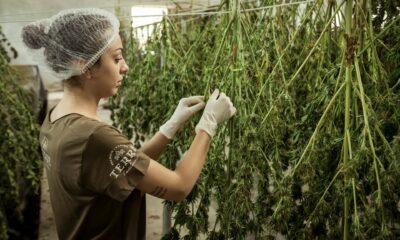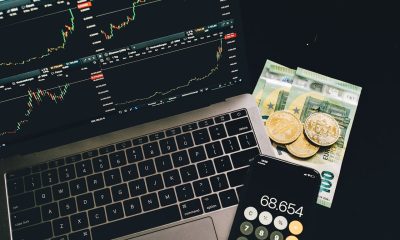Cannabis
First Legal Cannabis Crop Harvested in Ecuador
The partners of CannAndes in Ecuador have assured local media that it is still speculative to think about the possible profitability margins of their business venture. Although the Andean country is still behind Colombia and Uruguay, which are a few years ahead in the sector, cannabis already represents an opportunity for entrepreneurship and innovation.

Ecuador is betting on the cannabis sativa market. Since the National Assembly decriminalized non-psychoactive cannabis with less than 1% of tetrahydrocannabinol (THC) on December 24th, 2019, some Ecuadorian flower companies have been the most interested and venture into this sector.
That is the case of Klaus Graetzer, Felipe Norton, and Alfredo López, three young entrepreneurs, partners in a local flower company, who are now betting on the production of hemp for different therapeutic, pharmacological, textile, and even cosmetic uses. But they have not yet defined the sector of their interest and for now, they have obtained the seven licenses granted by the Ministry of Agriculture of Ecuador, and are cultivating nine hectares of cannabis in the small town of Tabacundo, known in the country as the world capital of roses, 60 kilometers from Quito, the capital of the Andean country.
Tabacundo is located in the Ecuadorian highlands at 2,877 meters above sea level and enjoys a perfect spring climate for this activity, with an average temperature of 15 degrees Celsius. CannAndes, the first company in the country to formally obtain all the official permits for the exploitation of this plant in Ecuador, was established here.
Read more about the legalization of cannabis in Ecuador and find the latest cannabis news with the Hemp.im mobile app.
The percentage of tetrahydrocannabinol or THC is what determines the psychoactivity of cannabis
In some countries, only cannabis plants below 0.3% or 0.2% of THC can be cultivated. In Ecuador, it is allowed to cultivate cannabis with 1% THC.. The psychoactive cannabinoid effect in human consumption refers to the capacity to influence the central nervous system and cause changes in mood, anxiety, stress, or modifications in cognitive processes. When the cannabinoid effect is psychotropic, it is understood that the effects in human consumption are equivalent to narcotic products.
This distinguishes hemp from marijuana. The former has no psychoactive or psychotropic effects and its uses include food, textile, and medicinal purposes. This is the bet that CannAndes is making in the search for a market where products from hemp or non-psychoactive cannabis can be offered, such as paper, biodiesel, hemp seeds, fabrics, and even nutritional supplements. The range is wide, according to experts.
For Hana Gabrielová Konopí, a researcher at the Department of Chemistry at the Institute of Chemical Technology in Prague, hemp, and marijuana are cousins, from the same family, but they are different varieties of the same plant. Hemp has been around since the beginning of human history. Christopher Columbus would not have known America if he had not propelled his caravels with sails and ropes made of hemp. The Han dynasty of China in the 2nd century B.C. would not have communicated imperial edicts or expanded its borders so efficiently without the invention of paper from hemp.
Gabrielová assures that cannabidiol from low-THC hemp has proven to be effective in the treatment of some diseases as an antipsychotic, anxiolytic, antitumor, anticonvulsant, neuroprotective, analgesic, anti-inflammatory and even to reduce the appetite for heroin, cocaine, and alcohol, among others.
The partners of CannAndes in Ecuador have assured local media that it is still speculative to think about the possible profitability margins of their business venture. Although the Andean country is still behind Colombia and Uruguay, which are a few years ahead in the sector, cannabis already represents an opportunity for entrepreneurship and innovation.
__
(Featured image by DEZALB via Pixabay)
DISCLAIMER: This article was written by a third party contributor and does not reflect the opinion of Born2Invest, its management, staff or its associates. Please review our disclaimer for more information.
This article may include forward-looking statements. These forward-looking statements generally are identified by the words “believe,” “project,” “estimate,” “become,” “plan,” “will,” and similar expressions. These forward-looking statements involve known and unknown risks as well as uncertainties, including those discussed in the following cautionary statements and elsewhere in this article and on this site. Although the Company may believe that its expectations are based on reasonable assumptions, the actual results that the Company may achieve may differ materially from any forward-looking statements, which reflect the opinions of the management of the Company only as of the date hereof. Additionally, please make sure to read these important disclosures.
First published in infobae, a third-party contributor translated and adapted the article from the original. In case of discrepancy, the original will prevail.
Although we made reasonable efforts to provide accurate translations, some parts may be incorrect. Born2Invest assumes no responsibility for errors, omissions or ambiguities in the translations provided on this website. Any person or entity relying on translated content does so at their own risk. Born2Invest is not responsible for losses caused by such reliance on the accuracy or reliability of translated information. If you wish to report an error or inaccuracy in the translation, we encourage you to contact us.

-

 Biotech2 weeks ago
Biotech2 weeks agoEcnoglutide Shows Promise as Next-Generation Obesity Treatment
-

 Business2 days ago
Business2 days agoThe TopRanked.io Weekly Digest: What’s Hot in Affiliate Marketing [uMobix Affiliate Program Review]
-

 Business1 week ago
Business1 week agoThe TopRanked.io Weekly Digest: What’s Hot in Affiliate Marketing [PureVPN Affiliates Review]
-

 Crowdfunding4 days ago
Crowdfunding4 days agoPMG Empowers Italian SMEs with Performance Marketing and Investor-Friendly Crowdfunding




















